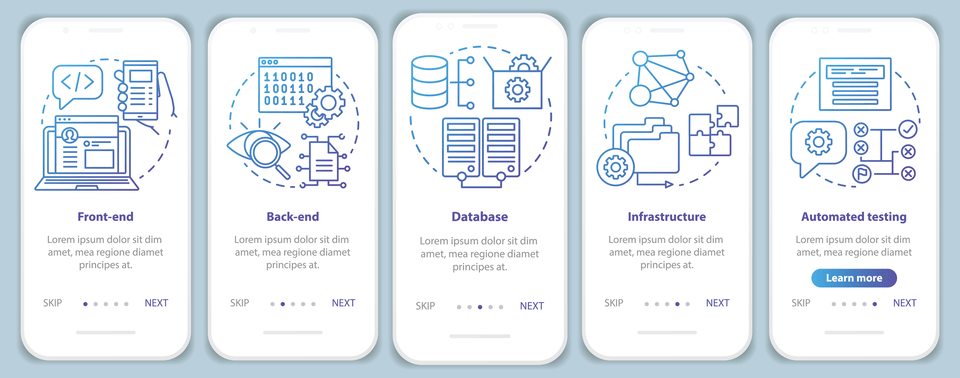Changes in the kinesthetic data streams, which are below the change detection threshold, can be ignored from a perceptual point of view and are hence not transmitted. This leads to an irregular subsampling of the original sensor data stream, which normally operates with an update rate of at least 1kHz. By decreasing or increasing the sensitivity threshold in the codec, i.e., by changing the corresponding deadband, the average packet rate can be controlled. This comes, however, at the price of lower perceptual transparency, where full transparency means that the user cannot distinguish between local and remote interactions. The resulting kinesthetic codec is able to reduce the average packet rate by about 80%–95% depending on the specific setup.
It produces the product in increments that implement the needed functionality in increments. Increments may be delivered to the customer as they are developed; this is called evolutionary, or incremental, delivery. The codec exploits Weber’s law of just noticeable differences, which applies for example to the perception of force, torque and velocity changes.
Data Breaches From LastPass: Recommended Steps To Prevent Them
Web projects have a baseline that is continuously evolving throughout the timeline of the project which needs careful and effectual management. Client and development team’s knowledge of the development process and methods to resolve the same. Interface analysis is a specialized technique in which specific requirements related to application development are determined and their interaction with other software components is measured. The SRS will include a vision or mission statement of the client company defining the overall objectives and business plans.
- You will be less likely to come across project risks and will also be more prepared for the upcoming projects.
- While the basic process of requirements gathering involves asking stakeholders for their input, sometimes stakeholders won’t know what’s best for a project.
- The requirements gathering and analysis phase is the first phase of the SDLC.
- These questions require attention and experience, this is why a security expert is a key role during the requirements phase of your SSDLC project.
- The failed local repair unit is then shipped to the second tier or even to the factory for repair or refurbishment.
You can filter for the critical path and set a baseline to track the variance between your planned effort and actual progress. It would also be beneficial to download a requirements-gathering template to get a leg up on your project process. This will help everyone align with business requirements, user requirements and system requirements. Record every single answer, and create an easily-accessible repository where others can access if they need to reference any information that was collected during the requirements gathering phase.
The Project Management Lifecycle: 4 Steps
The various techniques used by a project manager for requirements gathering include interviews, questionnaires, user observation, stories, prototyping, role-playing, and scenarios and use cases. And you can easily prevent them if you follow a requirements gathering process. The gathering technique involves precise research on what customers need. All ambiguities are removed, and the data flow is examined across various models. The elicitation process and subsequent analysis lead to a greater understanding of the system.

Lastly, be prepared for change and adopt a continuous improvement mindset to refine your SDLC processes over time. The SDLC is not a monolithic, single-step process but rather a multi-phased methodology. Each phase has its unique set of tasks and objectives contributing to the overall development effort. Speaking of the stakeholders, our free stakeholder analysis template for Excel will help you identify and manage your stakeholders. You can use this free template to describe the stakeholders involved with the project, what their relationship to the project is and the level of commitment, which helps you plan how to manage them. Whatever technique or combination thereof for requirements gathering, you’ll need to have them collected in a document.
Custom Software Development Costs – Your Budget Guide for 2023
Then requirements elicitation is performed, which focuses on gathering user requirements. After the requirements are gathered, an analysis is performed, which further leads to requirements specification. The output of this is stored in the form of software requirements specification document. Next, the requirements are checked for their completeness and correctness in requirements validation. Last of all, to understand and control changes to system requirements, requirements management is performed.
To ensure you’re fully prepared for the project life cycle, you can use the following research techniques. Creating and evaluating prototypes, analysis models, and other requirements views. These include but are not limited to customizable requirements hierarchy, what is requirement phase full support for agile and other methodologies, as well as full traceability regarding tests and bugs. Record every answer and try to create an accessible system that can be accessed by others when they require information from the gathering phase.
Requirement Analysis Phase
So, below we’ll delve into what exactly is involved in requirements gathering, why it’s important, and provide requirements gathering template. Requirements gathering is one of the most essential parts of any project and adds value to a project on multiple levels. When it comes to smaller budgets, tighter timelines and limited scopes, exact documentation of all the project requirements become crucial.

It sets a stronger foundation and a creates smoother course from the beginning to the end. Project managers can use Bit to create any type of project document, collaborate with the team in real-time, and store all project assets in one place for easy and fast access. You will be less likely to come across project risks and will also be more prepared for the upcoming projects. This eventually helps improve your project success rate and decreases the chances of a failed project. If you don’t take the time to understand the need for requirement gathering, you’ll end up facing a lot of difficulties and problems which you could’ve otherwise easily avoided.
Step 6: Monitor progress
One approach to defining requirements in this area is to survey the existing workforce skills, depth, and formal training, document these features, and use them as the baseline for the new network maintenance workforce. Any changes needed then can be handled as engineering changes to the baseline requirements and the existing workforce. You don’t have to use every answer you receive, but having everything documented can help you see all of your stakeholders’ perspectives, which will help you with requirements management. The goal is to document everything you can, so have all of the answers you need to start your project. The stakeholders are the people you’re ultimately developing the project for, so you should ask them questions that can help you create your list of requirements. But the consequences of ignoring these seemingly straightforward things can lead to injuries, cavities, or, in the case of project management, project risks.
By following an effective requirements gathering process, you will be able to focus on your business plans, provide on-target deliverables, and meet the requests and priorities of your stakeholders and clients. The goal of the spiral model of the software process is to provide a framework for designing such processes, guided by the risk levels in the project at hand. As opposed to the previously presented models, the spiral model may be viewed as a metamodel, because it can accommodate any development process model. By using it as a reference, one may choose the most appropriate development model (e.g., evolutionary versus waterfall).
What is capacity planning? Tips to apply the right strategy
Then, choose the most suitable SDLC model — for instance, waterfall for linear projects or agile for projects requiring flexibility and continuous iterations. By integrating an SDLC model into your software development process, your organization can reap these benefits, leading to high-quality https://www.globalcloudteam.com/ software, satisfied customers, and an efficient, effective development process. This includes documenting requirements, design plans, test results, and more. This documentation can prove invaluable for future reference, troubleshooting, and if modifications are required down the line.
